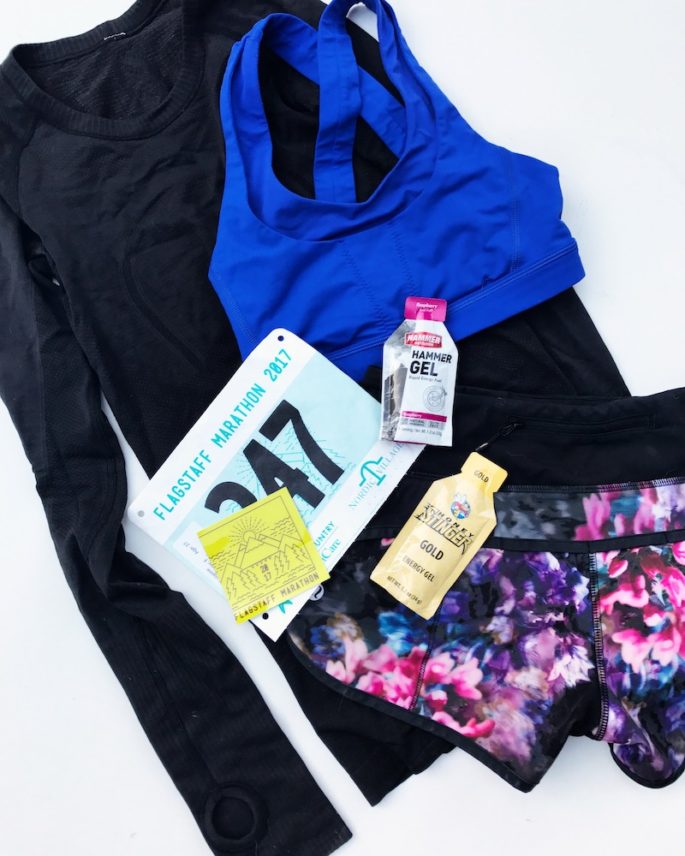
After months in the making, I did what I set out to do: ran a half marathon! I ran the half distance of the Flagstaff Marathon up in the high-elevation forests here in northern Arizona. Here’s how it went.
Training recap: by the numbers
20 weeks
60 training runs
256 miles
18,461 ft elevation gain
Race strategy
Pre-race
I did my longest run (12.5 miles) 2 weeks before my race. I scaled that back to a 9-mile run the Saturday before, then tapered down to 4- and 3-mile runs on Monday and Wednesday.
I didn’t try to adhere to any special diet the week leading up to the race. I stuck with reliable, home-cooked foods I knew would not make me sick, but I didn’t try to be extra healthy since that can lead to me not eating enough. I was mindful not to leave myself too hungry (but also not ridiculously full) for any meal to be sure I wasn’t going into the weekend with a calorie deficit.
For breakfast on race day, I had my usual pre-running meal: a slice of sprouted bread with nut butter and a little honey. It was about a 40-min drive to the race, so I planned to bring some granola to munch a little closer to the start time, but I forgot it at home! Instead, I had half a banana about 45 min before gun time which did the trick.
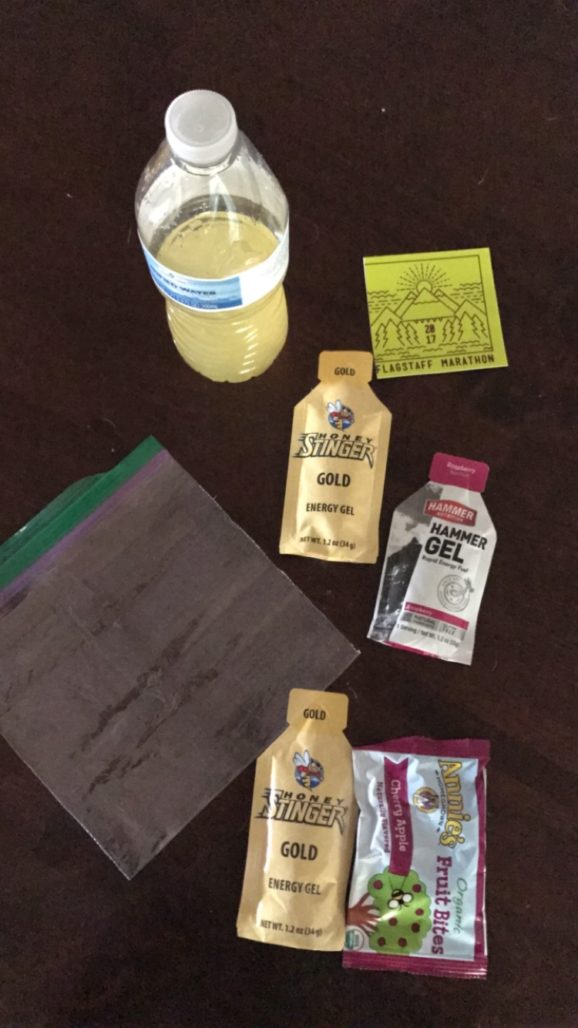
Fuel
I’d been experimenting with different fueling strategies during my training runs. I discovered that while they’re a bit awkward and sometimes not very tasty, gels work well for me. They take effect quickly and digest easily. I liked Clif blocks, but they did not seem to work as quickly, and the gel kind of got stuck in my teeth. I preferred being able to quickly suck down a gel while running rather than chewing a block. I also tried a little stroop waffle for fun, but that actually made me feel worse. Also, I accidentally discovered Annie’s fruit snacks work pretty well in a pinch. :) I avoided trying caffeinated products because I’m too sensitive to caffeine, not to mention it’s a diuretic, which I don’t want to deal with mid-race.
The other key for fueling was timing. In my training, I discovered what a tragic mistake it is to fuel too late. Taking the first dose 50-60 min into my run is about right for me. I don’t have as much experience with a second fuel-up, but about an hour and a half seems to work well, so that was my plan going in. I brought a 3rd gel as a backup in case I ended up moving slow.
I run with my Osprey Tempest 9 day pack, which, while compact and lightweight for a backpack, isn’t exactly minimal compared to most running packs. That said, I know it works for me, and it’s what I train with, so I wasn’t about to run out and get a new pack the week of the race. I prefer to race with my own water so I can sip slowly at the times it feels most natural for me. I packed around 1L of water and drank almost all of it.
Pace
Through my long runs, I’ve discovered it’s crucial for me to start slower than I think and ease in. If I start too fast, it doesn’t matter how much I slow down, I never recover. I’ve also learned from my previous races that starting toward the back of the pack helps prevent me from getting swept up in the pace of those running around me. I’ve developed a rule that I’m not allowed to pass anyone for the first couple of miles unless they are walking, which really helps keep me in check. With this in mind, I aimed to spend the first 2 or 3 miles at a 12-13 min pace (or slower uphill) and then and only then consider speeding up once I felt fully eased into the run.
Goals
I only had two simple goals for the race: don’t walk and finish in under 3 hours.
Not walking was important to me because, for one, I wanted to prove to myself that I could run a half marathon, not hike or run intervals for a half marathon distance. Also, more practically speaking, I find that walking breaks my mental pattern. Although in the future I’d like to improve this, currently anytime I’ve taken walk breaks during a run, I have a hard time re-establishing my rhythm and end up having a bad run.
As for my time goal, I was hoping for something closer to the 2.5-hour mark, but given that it had taken me a full 3 hours to run 12.5 miles two weeks before, I didn’t want to set unreasonable expectations.
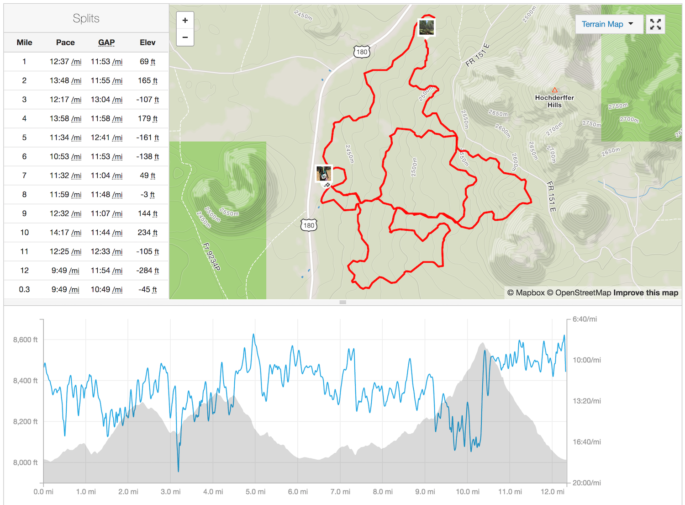
The race
Miles 1-4
The horn sounded and we were off, but…I didn’t exactly get off to a good start.
My legs started burning almost immediately. I didn’t have the “fresh legs” feel or any kind of start-of-race high, I just felt slow and draggy.
I swear the first mile was the longest mile ever.
A mild panic started to percolate in my mind. If I felt bad now, how was I gonna feel in 2 hours? I’ve done so many long runs that have gone well, why do these first couple miles feel like hell? Was this whole race going to be painful and mentally miserable? PULL THE FIRE ALARM.
Adding to that, there were several runners who were grating on my nerves. They would walk, I would pass, and then after I passed they would start running again, pass me, and then hit another incline and start walking. Rinse and repeat like 6 times. Although that might be the strategy that works for them, it was awfully annoying to be caught in the middle of it. I’m used to running alone with very few others on the trail, so having to deal with other runners on race day always throws me for a loop.
As my frustration started to build, I had to make a conscious decision to not get swept up in it and instead activate the disciplined part of my brain. I started to more actively work on blocking out the negative thoughts and the panic. I didn’t have to trick myself into being happy, I just worked on letting those negative thoughts float by instead of latching onto them. As dorky as it sounds, I made myself start mouthing along the lyrics to my music and jiving with it a little bit. Fake it til you make it, right?
Although I wasn’t having a good time yet, the “fire alarm” thoughts started to taper off. I stopped at the 3-mile aid station (the downward spike in my pace chart) for a few sips of electrolytes.
At the top of mile 4, I took my first gel. Mile 4 meant I also hit the top of the first big hill. So, I got hit with a burst of energy from my gel and the course eased up and my legs were finally shaking out and the field was finally starting to separate so I wasn’t dealing with other runners anymore.

Miles 5-8
Now I was in business.
As I started descending the first big hill, I started to pick up some speed and my legs found their rhythm. By the time I hit mile markers 5 and 6, I was feeling fine as hell.
For some reason, my “wall” with long runs is typically the first 3 or 4 miles. Most other people I’ve talked to say their sticky spot is more like miles 7-9. Not me. I often feel sluggish starting out, and then by mid-distance, I’m golden. That said, for some reason I always forget about this when I’m actually running and instead get worried when I don’t feel great right away.
I sailed through the middle miles, passing a few people and enjoying the break (which I knew was temporary!) from the big climbs. I took my second gel around mile 8, which worked out perfectly since I got it into my system before the big climb.
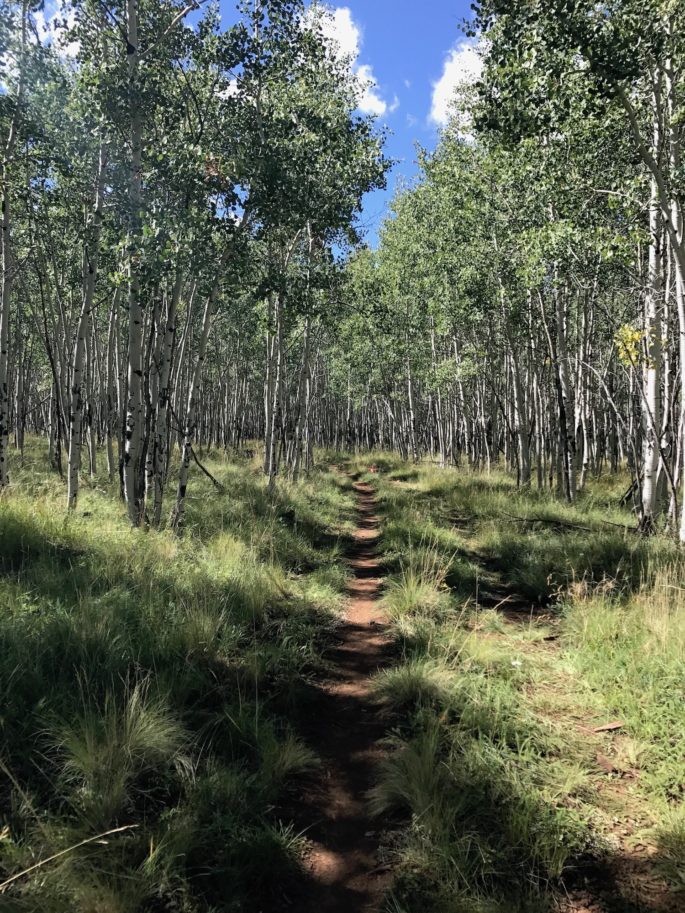
Miles 9-10.5
As I started the second big climb, I was still feeling pretty good. I backed off my pace, but still kept a good pace for the shallow, early part of the hill.
Then the suck started.
Although the course had been steadily climbing for a mile already, the really gnarly portion of the climb starts at mile 9. You get hit from all directions with this hill. First, you’ve already been running for 9 miles and you’ve already done a fair amount of climbing. Suffice it to say your climbing legs are not exactly feeling fresh. Second, you’re climbing up to 8,600 ft, and every foot higher means less and less oxygen. Third, the grade gets pretty ridiculous as you get to the top of the hill, think 10-15%. Fourth, portions of the climb get pretty technical, with intensely washed out troughs and rocky, rough segments.
It was spicy.
Fortunately, at this point, I had dialed in my mental game. I switched gears out of “OMG I AM ON FIIIRE” and redirected that confidence into the focused, sheer-force-of-will, deep-in-the-pain-cave mode. I told myself I had made it this far without walking, I had trained without walking, I would not walk this hill.
I felt the oxygen get sparse, my breath start to wheeze, and my heart rate climb. My pace dropped off to the saddest, slowest run you have ever seen.
But it was STILL A RUN.
I felt just slightly queasy at this point, perhaps from the sugar bomb from my 2 gels, perhaps from the climbing, or perhaps a whole mess of factors. I had packed another gel but decided not to take it because my body felt like it had had enough and I didn’t want to turn my stomach. I took a couple more swigs of electrolytes instead.
Miles 10.5-finish
Finally, I started to feel the trail inflect back down. I tried not to get my hopes up or speed up too quickly because I wasn’t 100% sure the climbing was over. Both my legs and lungs felt like they were made of actual fire at that point, so I kept it slow for a couple minutes to let my system recover.
After a few minutes, it became clear I was home free. My legs, lungs, heart rate, and nausea all eased up and I was free to crank up the pace. Thankfully, the grade going back down wasn’t too steep or technical so I could just enjoy the cruise downhill.
The loop back to the finish line intersected with an earlier segment of the course and I started to recognize where I was. I knew I was getting close to the end. I was almost sad to be getting to the end because the downhill made me feel like I could just keep going and going.
Sure enough, the finish line snuck up on me. I hit a clearing and there I was. I always like to empty the tank at the finish, and while I definitely accelerated into the last few hundred yards, I would’ve liked to push the pace a little earlier had I known just how close I was.

Finish line thoughts
Overall, I’m really happy with how the race shook out. Even with a shaky start, I rallied and ended up having a good race both mentally and physically. I had a 15k race at this same location a few weeks ago that was also a really strong race, and with this one I actually ended up averaging 3 seconds faster, even with more climbing and more miles.
I waffled a lot about which race to sign up for, but I’m glad I went with this one. Yes, it was a tough race, but I’m proud of the fact that I was able to step up to the challenge.
I had been concerned I didn’t train enough for such a brutal race–namely, I wished I had gotten a couple more 10+ milers in–but thankfully my fears were unfounded. I think my training prepared me perfectly to negotiate the challenging conditions. In fact, my race day performance was just as good if not better than my best training runs.
The race itself was extremely well-organized and well-marked. The aid stations were stocked with all kinds of goodies and all the race staff were very positive and helpful. Plus, they offered free lunch and beer at the finish line (in addition to the usual snacks), and it was delicious. The only downside of the race is that it’s a short course, somewhere between 12 and 13 miles, which was sliiightly unsatisfying given that it meant my first half marathon wasn’t technically a half marathon. But as I discovered through my training, I would rather do a really challenging, all-trail, high-altitude half marathon that’s short by half a mile than a full 13.1 on easy road conditions.
If you live in Arizona or would like to travel to the area and you’re looking for a fun but challenging trail race, I would recommend checking the Flagstaff Marathon out.
[ezcol_1half]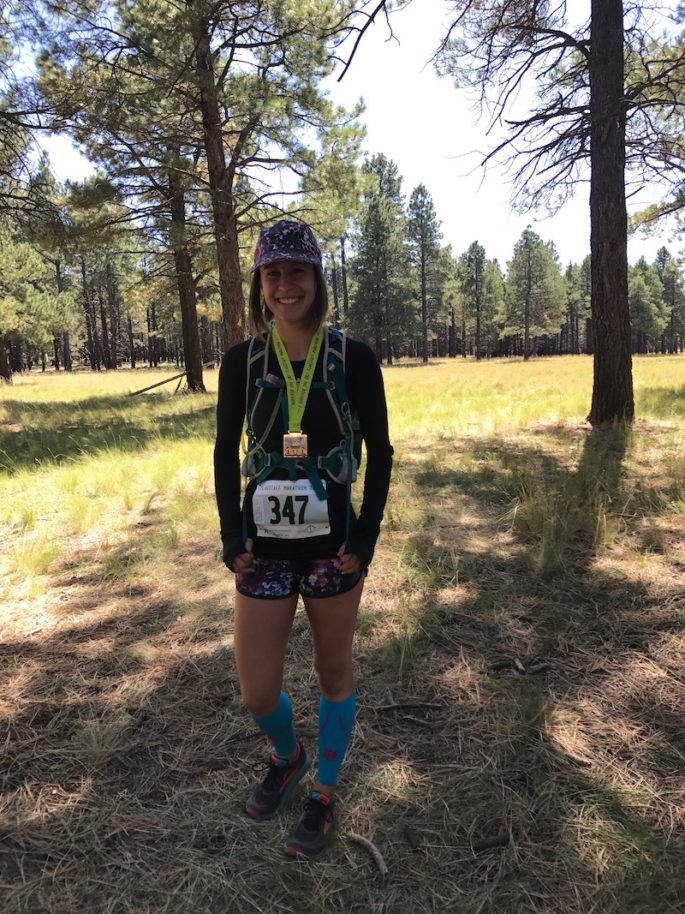 [/ezcol_1half] [ezcol_1half_end]
[/ezcol_1half] [ezcol_1half_end]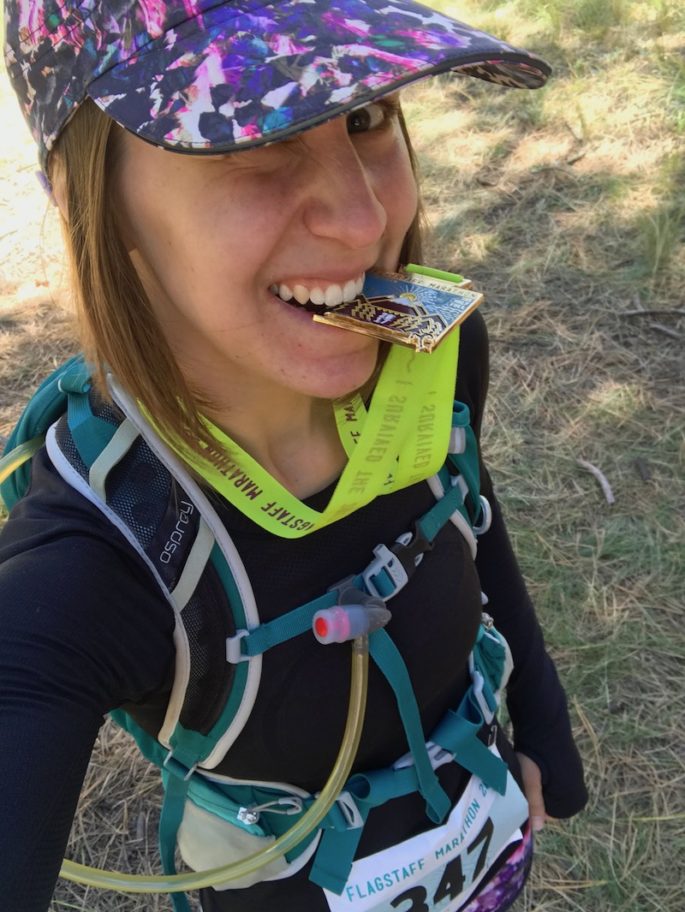 [/ezcol_1half_end]
[/ezcol_1half_end]
Race day: by the numbers
Official time: 2:30:41
Average pace (from app): 12:14/mile
Distance: approx 12.5 miles
Elevation gain: 1,762 ft
Min/max elevation: 7,975 / 8,589 ft
What’s next
This race was really the culmination of my training efforts since May. Now that I don’t have a race to train for, I’m free to rearrange and reprioritize my workout regimen.
In the immediate future, I’m going to spend a week or two taking it easy so I can let my body more fully recover from an intense final month of training.
Race training has meant it’s been difficult to juggle cross-training without devoting almost all of my free time to working out. Since I don’t have an impending race, I’d like to get back to building some strength to balance out my running. I’m thinking of re-doing some of the BBG workouts I did earlier this year and going to more open gym sessions at the aerial studio.
That said, I’m definitely not going to stop running. Fall is an incredibly beautiful time to be outside in Flagstaff and Sedona and there’s no way I’m going to miss out!
I’m not over the racing thing just yet, either. I really enjoy having a goal to train for, and I enjoy the mental challenge of distance running. And yes, I’d like to do another half–perhaps I’ll mix it up with something a little less brutal next time. :)







Great job! I remember how anxious you were about tackling running and I’m super impressed. You did amazing!
Thank you Jen! You’re right that I was pretty apprehensive, but I’m glad my fears were unfounded. :)
Well done! Especially on running without walking – those were some serious hills! I’m considering doing a trail half marathon – I’ve done a couple of road half marathons, and a couple of shorter trail races, so it seems like the next step. Like you I’ve found that trail races are more fun. But 21.1km of hills seems a bit daunting…
Thank you! Hills have really grown on me. I almost find flat runs boring now, haha. It’s worth it because you get to go down just as much as you go up. ;) Perhaps you’ll be pleasantly surprised if you start tackling longer distances on trails!
Congratulations! What an incredible achievement! I can’t even imagine the challenge of completing a half marathon at those elevations.
It’s interesting to note how the cross training drops off when you increase your runs. I find I’m exactly like that too and have taken a step back to do more full body workouts and more stretching!
With all your running did you find yourself needing to stretch/foam roll more?
Fortunately, I live at 7000 ft above sea level, so my body is pretty adapted to thin air. Granted, it’s never “easy” but you do get used to it! And yes, my legs definitely are much tighter more often with running. With weightlifting, I would be sore a lot, but the tension was different. With running, on the other hand, I’m rarely sore, but I’m almost always tight all through my legs. Getting a massage has never been better, lol.
congrats Suzanne!!! so amazing!!!! especially since you were such a run hater before ;)
i love those people at the finish line holding out medals…. for some reason it cracks me up to see them dangling treasures to get you to finish instead of water or whatever. haha.
I know, they were surprisingly aggressive with the medals, lol. It was kind of funny to me too. And thank you! I guess I ate my words with all the run hating…
Congratulations! That’s a great time for your first half, especially on trail! Sounds like you ran a really smart race. I also always hit the wall early (or, I guess, take more time than most to really warm up) so I can relate to those rough early miles.
Thanks Kate! I was glad I had a few races under my belt (including a longer one!), it really helped me find and subsequently avoid some pretty crucial pitfalls. And I’m glad I’m not the only one with the early wall problem. :)
yay, well done! especially with what sounds like brutal hills! your running posts always make me want to go run, especially now that it’s fall, AKA cross country running season.
Thanks! I hope you get a chance to get out in the lovely fall weather. :)